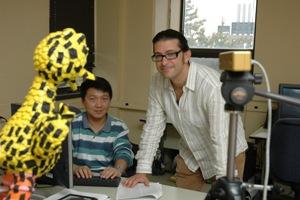Prof. Michael Greenspan from Queen's University in Canada has developed tracking software that will allow the ASSV autonomous space service vehicle to capture such a satellite in its orbit and dock it in the repair vehicle. Once the satellite reaches such a state, remote control from Earth can be used to repair the satellite

Scientists at Queen's University, Canada, are developing a new robotic system designed to service the more than 8,000 satellites orbiting Earth, far beyond the flight range of ground-based systems meant to repair them. Today, when the holiday satellite at a high altitude needs repairs or simply runs out of the fuel necessary to resume its activity, it becomes "space junk" that gradually accumulates in space.
"These are mechanical systems and that means they are ultimately designed to fail," says Michael Greenspan, a professor of electrical and computer engineering who leads the Queen's University project. Due to the fact that these satellites are thousands of kilometers above the ground, they are far from the operating range of expensive manned space flights while real-time remote controlled robotic repairs are simply not possible.
Prof. Grisfen's solution to this problem is the development of tracking software that will allow the ASSV - Autonomous Space Servicing Vehicle to catch such a satellite in its orbit and dock it in the repair vehicle. As soon as the satellite reaches such a state, remote control from Earth can be used to repair the satellite. "There is no need to carry out the repair itself in real time, since everything is in a fixed position and a human being can operate the system robotically from afar in order to do what is necessary."
The Queen's University team is currently working on the development of the ASSV with MDA - McDonald-Detweiller Associates - Space Missions, which previously developed the Canadarm and is responsible for all Canadian systems on the International Space Station.
Prof. Greenspan says that computer vision is the biggest technical challenge in capturing a satellite in orbit. Since these objects orbit the Earth in a "geosynchronous" orbit, their speed is synchronized with the Earth's rotation. The robotic system must first identify the satellite, then determine its movement and adjust the movement before the satellite is captured.
Due to poor lighting conditions in space, normal video cameras are only of limited use. The preferred sensor is in the form of a light-based radar known as LIDAR, which provides a set of three-dimensional points that precisely measure the satellite's surface geometry.
The Queen's University team, which includes students facing graduation in electrical and computer engineering, developed software that allows such a system to identify a satellite, determine its position and finally track it in real time using special ranging data. The Open team recently won a grant from the Natural Sciences and Engineering Research Council NSERC to continue researching the basic aspects of this new technology.
According to Prof. Grisfen, another potential ground application of the findings of this research is in the field of "flexible" production. By using vision systems and algorithms, it is possible to identify bodies and track them during their route in the production line. According to him, "as soon as we dare to do so, automatic production systems can interface more easily with the bodies themselves and the result can be a much easier and much more efficient production process."
Watch a video from Prof. Greenspan's lab showing a target object during real-time tracking.
to the announcement of the university
More on the subject on the science website

2 תגובות
Where did the proofing go?
Where did the spelling go?